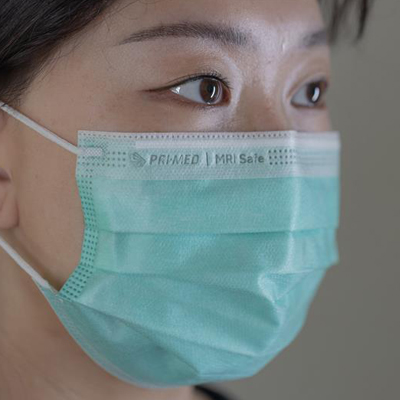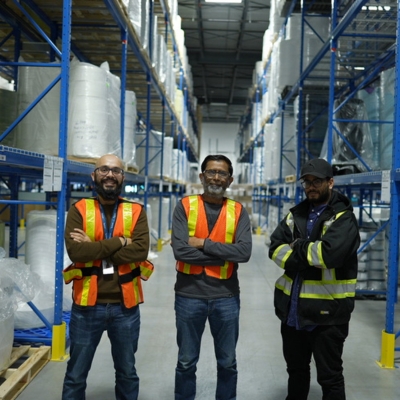Breathe easy

Addressing Concerns About Oxygen Levels and Face Mask Use
As the world adjusts to the impact of COVID-19 and masks continue to be a prominent part of daily life, it’s not hard to find mentions of masks making it hard to breathe or questions about mask-related medical concerns.
In this guide, we’re going to look into the design, testing, and manufacturing processes of PRIMED’s medical masks to help dispel common myths and explain how material choice, specialized designs, and rigorous testing provide effective protection with maximum comfort.
Materials Matter: How Textile Choices Impact Mask Characteristics
PRIMED’s single-use face masks are composed of popular textiles, such as spunbond-meltblown-spunbond and cellulose, used by companies worldwide for creating PPE and a range of other items.
Many of these textiles are non-woven, offering greater filtration and splash resistance than many woven textiles you might see used to make masks -- such as cotton, polyester blends, or silk.
Better still, by controlling the density and weight of the non-woven textile, we can provide multiple levels of protection with a range of bacterial filtration efficiencies, particulate filtration efficiencies, fluid resistances, and breathability.

We can then use cellulose layers as a skin barrier to provide a soft, comfortable surface and reduce the chance of skin irritation and other sensitivities.
This means that all masks aren’t created equal, and much of the difference starts in the material choice phase before masks are even manufactured.
PRIMED’s single-use face masks meet ISO (International Organization for Standardization) certifications for skin sensitivity and cytotoxic testing. We also never use nanoform graphene in any of our products.
Biocompatibility testing ensures that materials used for mask production are safe at all times.
While wearing a facemask will probably never be as comfortable as not wearing one, our emphasis on materials means we can offer an exceptional balance of comfort and protective benefits--even during extended wear.
Proven Breathability with ASTM Ratings
Our medical face masks come in multiple ASTM rating levels (1, 2, or 3) to provide varying levels of protection.
However, meeting ASTM ratings isn’t simply about filtration capabilities or fluid resistance.
These standards also measure breathability to ensure masks are safe to wear for extended periods or during critical operations.
Breathability is tested by determining the Delta P or differential pressure rating of the mask.
Delta P measurements in excess of 6 mm H2O/cm2 are typically considered too hot or restrictive for extended use.

Our ASTM Level 1 rated masks all feature a Delta P less than 5 mm H2O/cm2 and would be considered acceptable or cool for long-term wear.
This makes them ideal for use in many workplaces or when in crowded environments for extended periods.
ASTM Levels 2 and 3 feature higher Delta P ratings but fall below the 6 mm H2O/cm2 threshold to ensure comfort.
PRIMED for personal use: We offer the same top-quality PPE we sell to leading healthcare providers for home use. Check out our online store to buy face masks for your family.
Tips to Help Increase Your Comfort While Wearing a Mask
Multiple studies, including this 2020 study in The Annals of the American Thoracic Society, have shown that well-designed single-use medical face masks have little impact on oxygen levels or breathing ability.
For most mask wearers, a pulse-oximeter (or even your iPhone or fitness wearable) can provide an easy-to-use and accessible means of monitoring your oxygen saturation levels and gauging the true impact of mask use for you.
If your oxygen saturation levels are good, but you still find masks too uncomfortable, these tips might help.
1. Consider the Fit
While it’s essential to minimize gaps around the cheeks and face, your mask might aggravate your dyspnea if it’s too tight.
Consider tying knots in earloops, using an ear saver device, or adjusting the metal nosepiece on your mask to alter the fit and see if your experience changes. Read our guide on mask fit considerations for more ways to get the most out of your face mask.
2. Adjust the Mask Type
If you’re using an N95 mask for extended periods, your discomfort could be much more significant.
These masks are intended solely for clinical use for controlled periods.
Choosing an ASTM-rated single-use medical facemask will provide protection with easier breathing than wearing an N95 mask.
3. Take Occasional Breaks
Even occasional breaks--even just a couple of minutes--can considerably impact mask discomfort, reduce skin irritation, and prevent ear soreness.
However, be sure that you can remain safe while taking your mask break.
Bring a fresh mask out for your break so you can don a new mask before returning without increasing the risk of contamination from touching a worn mask.
If you’re in the car alone, walking outdoors without others nearby, or at home around healthy family members, there’s usually no need to mask, depending on local regulations.
Key Takeaways
- Mask materials play a significant role in determining mask breathability and comfort.
- Masks made of materials tested for biocompatibility are less likely to cause skin interactions or other discomforts which might aggravate your breathing.
- All ASTM-rated masks meet strict testing standards related to fluid resistance, filtration capabilities, and breathability.
- If you’re concerned about the impact of mask-wearing on your oxygen saturation levels, a pulse-oximeter is an affordable, easy-to-use way to monitor this important health metric. Many fitness wearables and some cell phones can also take this measurement.
- Many studies have shown that wearing ASTM-rated single-use face masks has minimal impact on rebreathing CO2, hypoxemia, and overall gas exchange.
- If you’re experiencing discomfort, always consult with a medical professional as this could indicate other serious health concerns.
- Adjusting your mask fit can also help to alleviate feelings of dyspnea. While a loose mask has poor protective abilities, a too-tight mask can make it feel harder to breathe.
- Take time when it’s safe to take mask breaks. Even a few minutes throughout the day can make a huge difference in alleviating discomfort, preventing skin irritation, and soothing sore ears.
PRIMED is a leading supplier of high quality PPE to healthcare professionals and the public. Our innovative designs, high-quality materials, and ability to control the manufacturing process from start to finish allow us to provide a quality product with consistency and reliability few manufacturers can match. Contact us today to discuss your needs or browse our product selection.
Related Resources
PRIMED MRI Safe Mask: Safe by Design for Purpose-Built Protection
PRIMED's ASTM Level 3 MRI Safe Masks offer a high-quality, purpose-built solution that merges MRI compatibility with premium protection.

From the Sterile Core to the Decision Table: Elevating the Voice of MDR Professionals
MDR professionals don’t just process products, they influence how they are designed, selected, and standardized.
%20-%20Sterlization%20Wrap%20Display%20(1).jpg)
Protecting with Purpose: The Supply Chain Behind the Mission
PRIMED, resilient through the pandemic, has evolved our supply chain - now stronger, smarter, and ready to meet future challenges with agility and confidence.


